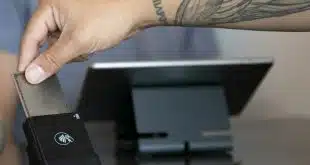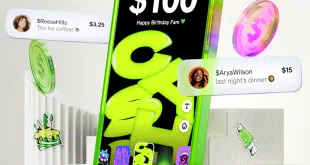Jane Adler
With a growing array of digital wallets, retailers are testing multiple strategies—all at once.
When it comes to digital wallets, retailers are like kids in a candy store. Lots of sweet offerings are on display. But instead of picking a favorite, some merchants take one of each to see what’s best.
Big retail chains—Macy’s, Jamba Juice, and Foot Locker, to name a few—have signed up for multiple digital wallets from third-party providers. Retailers are developing their own wallets too. Forward-looking merchants don’t want to get caught without the system their customers prefer as payment, couponing, and loyalty programs using smart phones develop. So these retailers are testing several digital-wallet strategies, trying to figure out which one might deliver the most value, namely, lower transaction costs and higher sales.
The sheer number of choices can be overwhelming, however. Retailers face a barrage of new mobile-payments and loyalty offerings. By one count, nine major digital-wallet initiatives have been announced.
Some of the big players are Google Inc., PayPal Inc., and Isis, the mobile-wallet system offered by telecommunications carriers AT&T Mobility, Verizon Wireless, and T-Mobile USA. Visa Inc. and MasterCard Inc. have digital wallets. Sprint Nextel Corp. is reportedly working on a wallet solution. Facebook Inc. and American Express Co. with its Serve platform are rolling out digital wallets.
Apple Inc., the subject of unending speculation in payments circles, announced in June that it was entering the wallet market with an application called Passbook that should be available this fall. Starbucks Corp., Target Corp., Apple’s own stores, and other retailers are reported to have integrated with the system. Added to that, so-called containers, or wallet-management systems like the mobile-phone app by Lemon.com, are available to keep a consumer’s various payment and loyalty cards organized.
Some wallet systems are open-loop, others are closed. There are cloud-based and physical point-of-sale systems. At least one wallet doesn’t even require a cell phone. Workarounds and add-ons, related in one way or another to digital wallets and mobile-payments technology, seem to emerge daily.
“Confusion reigns,” says Mark Horwedel, chief executive at the Merchant Advisory Group (MAG), a Minneapolis-based retailer trade group. “There are so many things coming at us.”
Tightlipped Merchants
Horwedel admits that the quickly changing mobile-payments landscape has led some retailers to take a wait-and-see approach for fear of adopting the wrong system. Shopkeepers don’t want to pay for costly system upgrades either.
“There’s some paralysis among retailers,” he says.
Meanwhile, consumers don’t seem all that eager to trade their plastic cards for a phone-based payment system. In a recent survey by CatapultRPM, a behavior-based marketing firm in Westport, Conn., 58% of consumers were either completely uninterested, or not very interested, in using a digital wallet.
Also, 67% of consumers were worried about their privacy when using a mobile wallet, and 42% of consumers wouldn’t trust a wallet from many of the makers. Consumers were most leery of wallets from retailers and phone companies.
Despite the wariness and confusion, digital-wallet adoption among retailers is moving ahead. One-fifth of the top 100 retailers have launched a trial mobile wallet, according to a recent study by First Annapolis Consulting Inc., Linthicum, Md.
“Retailers aren’t picking one wallet,” says Jeff Crawford, senior consultant at First Annapolis. “Merchants are experimenting.”
Most of the experimentation is taking place among large retailers. They have the staff and know-how to set up the systems. Some experimentation is also taking place among small, tech-savvy retailers willing to try new ideas. The bulk of retailers in the middle are content, for now, to see how the market evolves, or to let their merchant-acquirer partners make the decisions.
The adoption by some retailers of multiple wallets has been boosted by the fact that wallet providers do not require merchants to sign exclusive agreements. After all, providers want retailers in their wallets. Most wallet providers don’t charge retailers to be included in the wallet either, so retailers can try out a number of wallets at once.
Retailers are not just experimenting with multiple wallets, though. Some merchants have their own wallet systems. The most notable example is Starbucks with its smart-phone application. Consumers retrieve their account information from their phone at the point of sale in the form of a bar code that is scanned for payment.
Many industry insiders consider the Starbucks digital wallet, a stored-value card that sits within the mobile application, to be one of the most successful in the industry to date. Starbucks logged 26 million mobile transactions in 2011.
Closed-loop programs, like the Starbucks wallet, probably will be the most prevalent way for merchants to participate in digital wallets for the near future, according to Horwedel. In that scenario, merchants don’t have to worry about third parties that set the rules and design the products.
“Retailers can make decisions for themselves,” says Horwedel.
In March, news broke that about two dozen retailers, including Wal-Mart Stores Inc. and Target, plan to start a merchant-controlled mobile-payments network. Dubbed Merchant Customer Exchange (MCX), the network also includes 13 other named merchants and some unidentified ones.
Merchants in general are tightlipped about their mobile-payments experiments. Some of the most active ones testing multiple digital wallets, including Macy’s, Jamba Juice and Foot Locker, all failed to respond to Digital Transactions’s requests for comment.
Merchant Agenda
What is known is that for the first time in a long time, retailers have an opportunity to weigh in collectively and determine how payment technology is going to evolve, according to Steve Mott, principal at consulting firm BetterBuyDesign, Stamford, Conn. That means merchants will continue to sign up for a number of different virtual wallets.
“It’s inexpensive and painless to experiment,” says Mott, who helped MCX get under way.
Merchants have several goals. At or near the top of the list is finding a way around the costs associated with accepting general-purpose credit and debit cards.
“Retailers don’t want to see mobile payments layered on to the existing payments system, adding yet another fee,” says MAG’s Horwedel.
Merchants would also like to avoid the high costs that accompany compliance with the Payment Card Industry data-security standard (PCI). They want a secure system that allows them to keep control of customer data to deliver offers and discounts to consumers.
At the same time, retailers are leery of how customer data will be used by wallet providers.
“There’s a fair amount of concern among retailers,” says Horwedel. He explains that merchants believe the customer information given at the point of sale belongs to the merchant. “They don’t want their data taken from them, and sold back to them at a premium.”
The marketing potential of digital wallets doesn’t appeal to all retailers, however. Big-box stores that focus on low prices instead of special discounts don’t see the advantage of the snazzy electronic coupons that wallets can provide.
Retailers have other gripes. Vendors are hyping the products, merchants say, but consumers aren’t clamoring for digital wallets. And adoption will probably take longer than vendors predict.
Also, point-of-sale systems to handle mobile transactions can be expensive and become obsolete quickly. Customers easily get confused with new payment methods. Store employees have to be trained how to use wallet systems. And, finally: Retailers don’t want to clutter up valuable and limited counter space with lots of new devices.
Testing Wallets
Still, there are success stories. In January, The Home Depot Inc. adopted PayPal’s digital wallet. The pilot ran in three stores and quickly expanded to seven. By early March, the PayPal system was installed in more than 3,000 Home Depot stores.
“We’re thrilled with the results so far,” says a spokesperson for Atlanta-based Home Depot, though he declines to provide numbers.
To pay with PayPal, Home Depot customers use the PIN pad at checkout, entering their phone number and a personal identification code to complete the transaction. “Customers can walk into the store without a phone or a [physical] wallet,” notes the spokesperson. Customers receive a paper receipt and also an electronic receipt via text to their mobile phone.
Transaction costs for the PayPal system are less than a traditional card swipe, the spokesperson says. Asked whether Home Depot will try other digital wallets, the spokesperson says the company is open to considering other wallets or payments systems.
Big restaurant chains are already tinkering with multiple wallets, according to Dave Matthews, senior vice president and chief information officer at the National Restaurant Association, Chicago.
“Companies are in the learning stages,” he notes. But, he adds, “We don’t see widespread adoption yet.”
Digital wallets could prove to be an advantage for some restaurant operators, though, including quick-service outlets that need to move customers fast. A digital wallet could also improve the customer experience at fast-food outlets, since the clerk can spend less time on the transaction and more time with the customer.
Besides the big chains, single-location restaurants or small stores are testing digital wallets. Often, such establishments have young and tech-savvy owners and cater to customers who use smart phones for many functions, including mobile payments.
Jason Richelson owned a small chain of food and wine stores, the Greene Grape, in the New York area. He grew so tired of servers for point-of-sale systems at each store crashing that he decided to start a cloud-based POS company, ShopKeep.com Inc. The New York-based firm offers a cash-register system that runs on Apple’s iPad.
ShopKeep recently started a pilot program using PayPal’s digital wallet. Customers, who when first using the system provide an electronic picture of themselves, can check in via PayPal on their mobile phone when they enter a store that uses the ShopKeep application. At checkout, the cashier asks customers if they want to use PayPal, and, if so, the cashier then clicks on the POS system’s PayPal button.
The customer’s picture then shows up on the terminal and the customer does not need to present a smart phone for scanning. A big advantage of the system is that it exists in the “cloud,” an off-site server, and does not rely on a touch-screen PC for data storage.
ShopKeep.com has 2,000 customers who pay $50 a month per terminal. Richelson says he’ll be able to integrate the system with any digital wallet that wins consumer approval, though he thinks it will take time.
“It’s hard to train consumers to do something else,” notes Richelson. “Swiping a card is still super fast. It’s not a problem.”
‘POS Paranoia’
The big carriers backing Isis hope that sheer scale will convince consumers and retailers to adopt their digital wallet. Plans called for Isis to begin service late this summer in Austin, Texas, and Salt Lake City. About 300 merchants in the two launch cities will offer the service. National chains are participating in the test, including Dillard’s, Foot Locker, Jamba Juice, and Macy’s.
“In order for the wallet to have value, the platform needs scale,” says Jaymee Johnson, head of marketing at New York-based Isis. “This is a robust platform.”
The Isis wallet, similar to Google Wallet, uses near-field communication (NFC) technology to communicate data between the phone and POS terminal (an important distinction is that, while Google still uses NFC for in-store transactions, it released last month an update of its wallet app that stores users’ cards on a Google server rather than in the secure element in an NFC phone.)
Mobile phones and POS terminals must be equipped with an NFC chip for the Isis system to work. Phone makers are starting to include NFC chips in their new devices, though they’re still uncommon in the U.S.
Meanwhile, some forecasters predict NFC-enabled POS terminals will make their way into more than 50% of merchant locations by 2015, especially now that the payment card networks are developing plans for EMV chip card payments in the U.S. that also will accommodate mobile payments.
“That’s just around the corner,” says Johnson, adding that Isis is working with terminal makers, such as VeriFone Systems Inc. and Ingenico S.A. “NFC will become increasingly common.”
For merchants, Isis is also rolling out a “Smart Tap” service. It allows consumers to receive and redeem rewards and coupons at the point of sale. But special software at the merchant’s terminal is needed to process the offers. Only several dozen retailers in the Isis launch locations will have Smart Tap-enabled terminals.
Whatever digital wallet systems are adopted, retailers will have to invest in new POS systems, which means the systems will be subject to hard-nosed financial analysis.
“Retailers want to see a return,” says the Merchant Advisory Group’s Horwedel.
MAG’s upcoming October conference includes a roundtable of retailers titled, “POS Paranoia.” Merchants fear that whatever terminals they buy will be outdated in six months, Horwedel explains.
Still, retailers will continue to experiment and, eventually, there will be winners and losers. But Horwedel recommends keeping an eye on the big merchant mobile effort, MCX. “That will tell you what the large merchants are thinking.”




